Fairytale places that can make you feel like a king and queen for a day, full of history and magic: these are the castles of Italy. Among the narrow streets of picturesque villages, they can be found on majestic peaks, nestled in enchanting forests and woods or caressed by the waves of the sea.
Castles in Italy, so different from each other and so majestic, tell far-away stories, on the border between reality and fantasy, populated by more or less famous and more or less real characters, but certainly intriguing, thanks to stories of tragic romances and wars. Come with us and find out where to live your fairy tale.

I am intrigued by the life that old castles have seen and still partly retain. Who knows how many dreams are left on the towers.
Why visit the castles in Italy
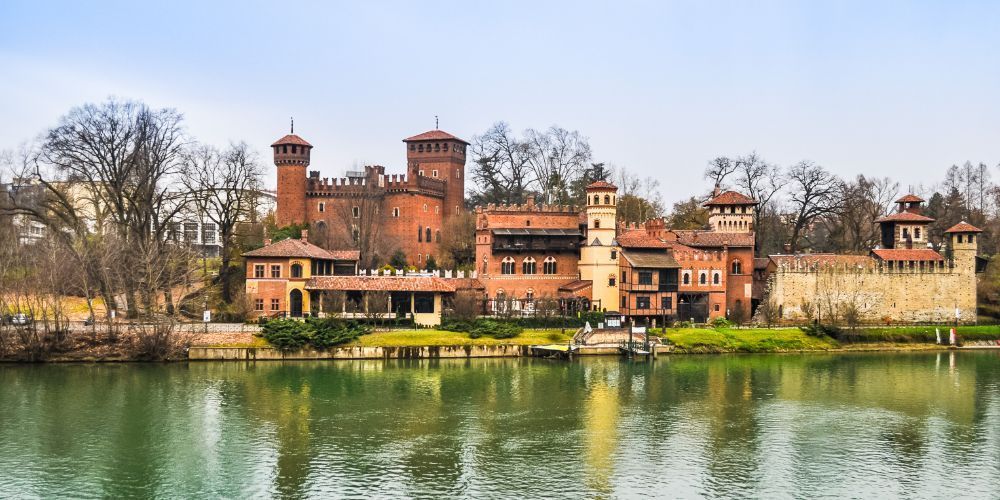
Italy is a place filled with natural and historical beauties. Between the sea and the mountains, small villages and modern cities, there is always so much to discover. The castles of Italy, however, have an immense historical value that makes them particularly significant.
They were the core around which the life of entire communities took place for centuries and at the same time defensive works, centers of power and politics, residences for the ruling powers, as well as among the main centers of Italian maecenatism. Artists, musicians and poets lived there, as well as scientists, philosophers and mathematicians on the payroll of nobles and sovereigns. These buildings, moreover, are splendid and complex architectural works.
Today the castles of Italy still maintain their complex nature, making them interesting from every point of view. So let's explore the 25 castles of Italy, from North to South, that we have selected for this enchanted journey.
25. Savoy Castle in Gressoney-Saint-Jean (Aosta Valley)
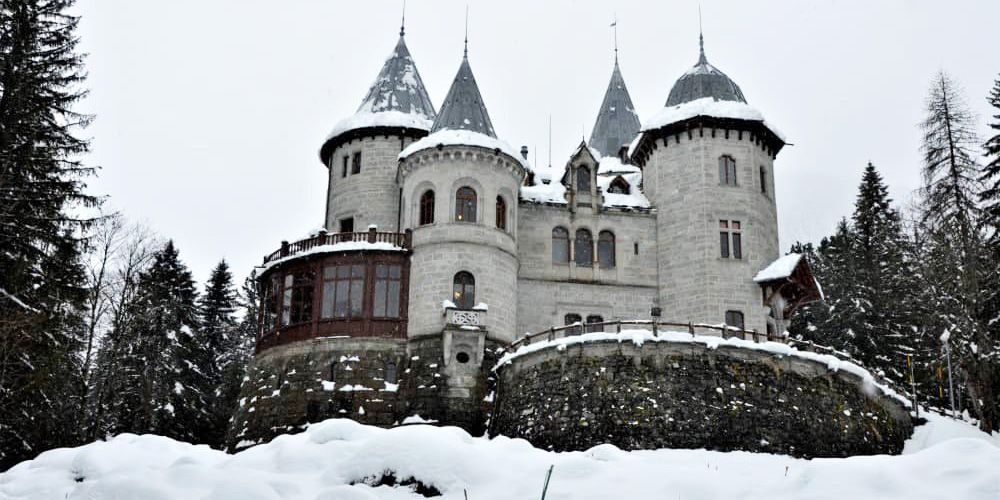
Nestling in the Gressoney-Saint-Jean Valley, among the mountains and the thermal baths of the Aosta Valley, ther is Castel Savoia, also known as the Castello della Regina Margherita, a nineteenth-century villa looking like the typical fairytale castle, that makes it one of the most beautiful castle of Italy.
The fortress is at the foot of the Colle Della Ranzola, nicknamed Belvedere, built between 1899 and 1904 at the behest of Queen Margherita di Savoia, wife of King Umberto I. The elegant mansion was used as a summer holiday residence where the queen stayed for long periods, hosting distinguished noblemen, artists and writers. After several years of disuse, the castle was purchased by a Milanese industrialist and eventually became the property of the Autonomous Region of Valle d'Aosta. A beautiful alpine park surrounds the castle, recommended to be visited in summer.
24. Valentino Castle in Turin (Piedmont)
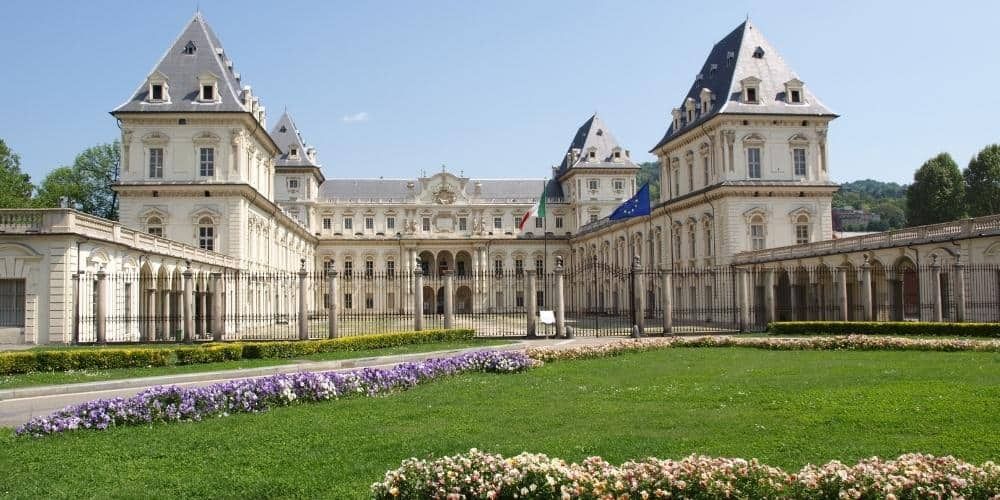
The Valentino Castle owes its name to the area in which it is located, named Vallantinum due to the presence of a waterway, the Valentino bealera. It was purchased by Emanuel Philibert of Savoy in 1564 after the capital of the Savoy duchy was moved to Turin, following the Peace of Cateau-Cambrésis. It consists of a 4-floor villa overlooking the Po River. It was Christina of France, first Madame Royal, who transformed the building into a maison de plaisance on the transalpine model.
The rooms inside are all decorated with frescoes and stuccoes that follow the same narrative thread. The exteriors are also remarkable; in fact, among the numerous castles in Italy, this manor is also notable for its namesake Valentino Park, among the largest and most beautiful in Turin.
Since 1997, the castle has been listed as a World Heritage Site and is part of the UNESCO serial site Residenze Sabaude, all must-sees.
23. Royal Castle of Moncalieri (Piedmont)
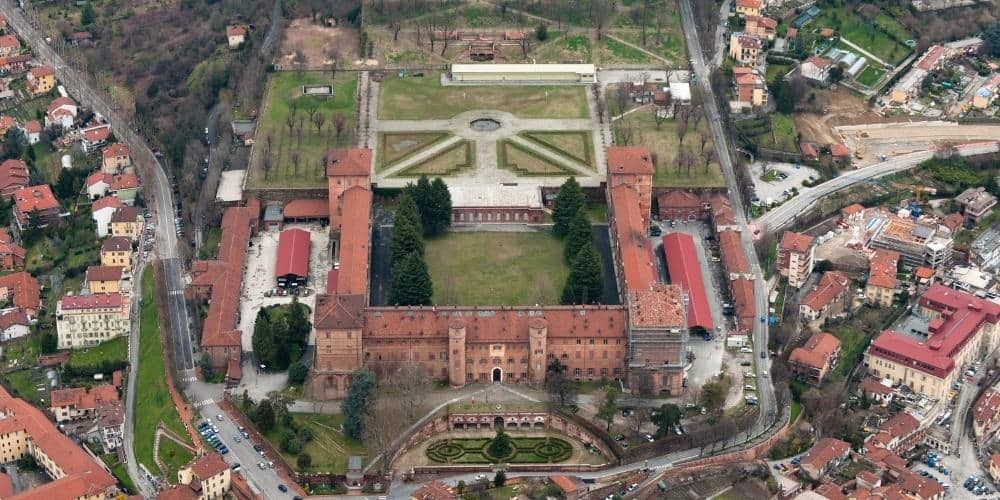
The Royal Castle of Moncalieri stands on the top of a hill in the historic centre of Moncalieri, the metropolitan city of Turin. This is not only one of the most interesting castles in Italy, this manor in fact, together with the other Savoy residences, has been on the UNESCO World Heritage list since 1997.
The current structure of the castle is horseshoe-shaped, facing north, with four massive parallelepiped corner towers. The lateral bodies have five storeys, and the brick walls have strong buttresses. The southern façade overlooks a small Italian garden and has two cylindrical turrets, the remains of the ancient 15th-century castle. The viewpoint at the north entrance is quite original.
Its English garden, which stretches across the hillside for about 10 hectares, is mesmerizing. Inside you will find the Cavallerizza, the largest of the Savoy residences, the Casa del Vignolante, the Torre del Roccolo, and the lily pond.
Be enchanted by the elegant Turin22. Sforzesco Castle in Milan (Lombardy)
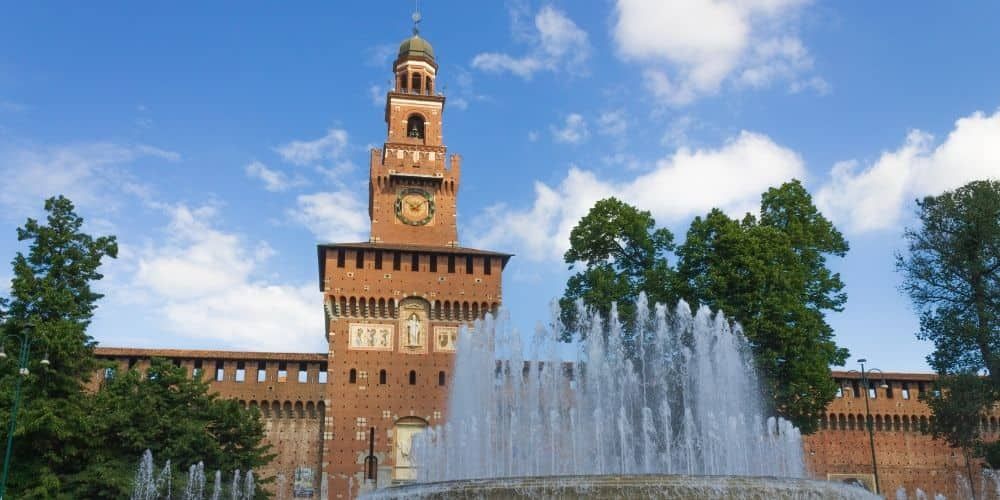
The Castello Sforzesco is the major fortified complex of Milan, located just outside the city center. It was erected in the 15th century by Francesco Sforza, who had become Duke of Milan, over an earlier 14th-century medieval fortification known as Castello di Porta Giovia. Even earlier, in Roman times, the Castrum Portae Jovis, one of the four defensive castles of Roman Milan, stood there.
Significantly remodeled and transformed over the centuries, between the 16th and 17th centuries, Castello Sforzesco was one of Europe's leading military citadels. Between 1890 and 1905, it then acquired its present historicist-style appearance.
Today it is home to cultural institutions and important museums. It is one of the most remarkable castles in Italy and in Europe, as well as one of the main symbols of Milan.
Visit Milan with Milan City Card21. Visconti Castle in Pavia (Lombardy)
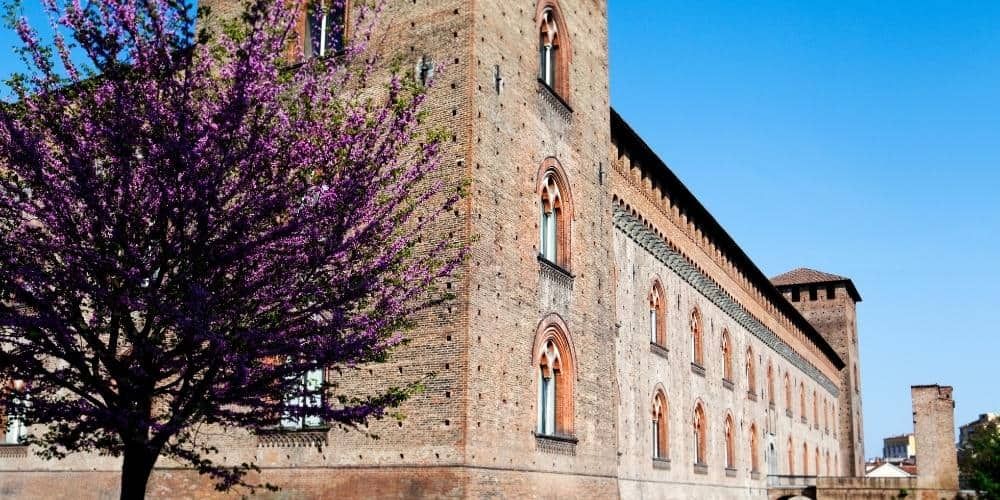
The Visconti Castle in Pavia was built in 1360 by order of Galeazzo II Visconti. Later the building was the court seat under Gian Galeazzo and his son Filippo Maria.
The Visconti Castle in Pavia was built in 1360 by order of Galeazzo II Visconti. Later the building was the court seat under Gian Galeazzo and his son Filippo Maria.
Near the castle, the Visconti family also had a magnificent hunting park known as Parco Visconteo, which initially extended for about ten kilometres, and reached the Certosa di Pavia. Today, part of the area still exists but is no longer connected to the castle: it's called Parco Della Vernavola.
To make the Visconti's residence one of the must-see castles in Italy, there's also the important museum complex that can be found there. Since the Second World War, the castle has indeed housed the Civic Museums of Pavia. They are divided according to the historical period of the exhibits, they are the Archaeological museum and Lombard hall, the Romanesque and Renaissance museum, the Malaspina Pinacotheca, the17th and 18th-century Museum, 19th-century Picture Gallery, the Risorgimento Museum and the Museum of Modern art and Plaster Casts.
Pavese Museum of the Risorgimento is particularly noteworthy, founded in 1885 thanks to private donations. The findings date from the Lombardy-Venetia Kingdom to the First World War, with a focus on the artefacts linked to the territory. There is also a section dedicated to Giuseppe Garibaldi.
20. Buonconsiglio Castle in Trento (Trentino-Alto Adige)
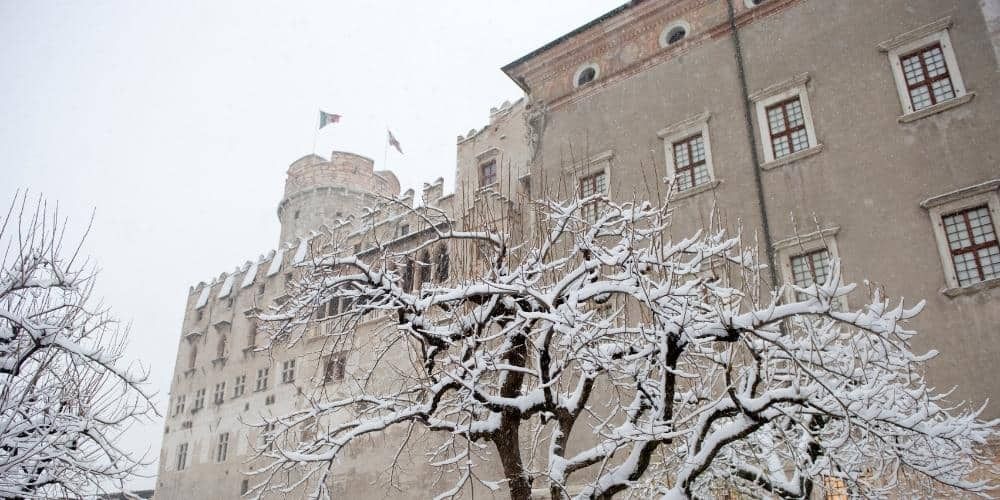
The Buonconsiglio Castle is one of the best-known buildings in Trento and one of the largest monumental complexes in Trentino-Alto Adige. It is made up of a series of buildings from different periods, enclosed within a wall in a slightly elevated position above the city.
Castelvecchio is the oldest core, dominated by a mighty cylindrical tower. Torre Aquila, at the southern end, inside preserves the famous Months Cycle, one of the most remarkable secular-themed pictorial cycles of the late Middle Ages that make this place a must-see among the castles of Italy alone.
The Magno Palazzo, on the other hand, is the 16th-century extension in Italian Renaissance forms and preserves an important Mannerist pictorial cycle in an excellent condition. Giunta Albertina, the last part, is 17th-century and Baroque in style.
19. Miramare Castle in Trieste (Friuli Venezia Giulia)
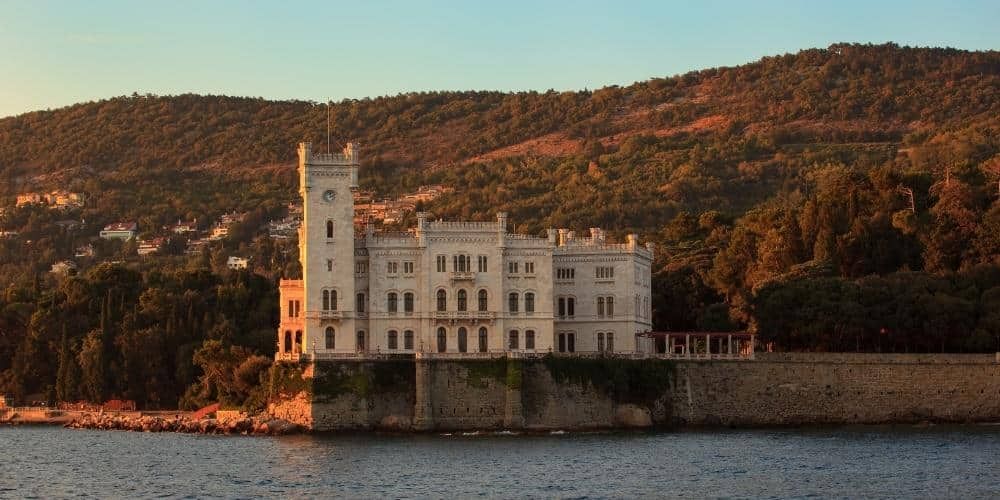
Let's discover one of the most popular destinations in Trieste. Just outside the centre is Miramare Castle, once the private residence of Maximilian of Habsburg.
Due to its privileged position this castle enjoys a magnificent view but is itself a true gem of the Trieste seafront. Built on the Grignano cape, the castle is right on the seashore and also has a beautiful park with an Italian garden, which alone is worth visiting.
Miramare Castle, among the most visited of the Friuli region, is built in eclectic style and retains its elegant original furnishings.
Don’t miss a visit to the Miramare Castle18. Castelvecchio in Verona (Veneto)
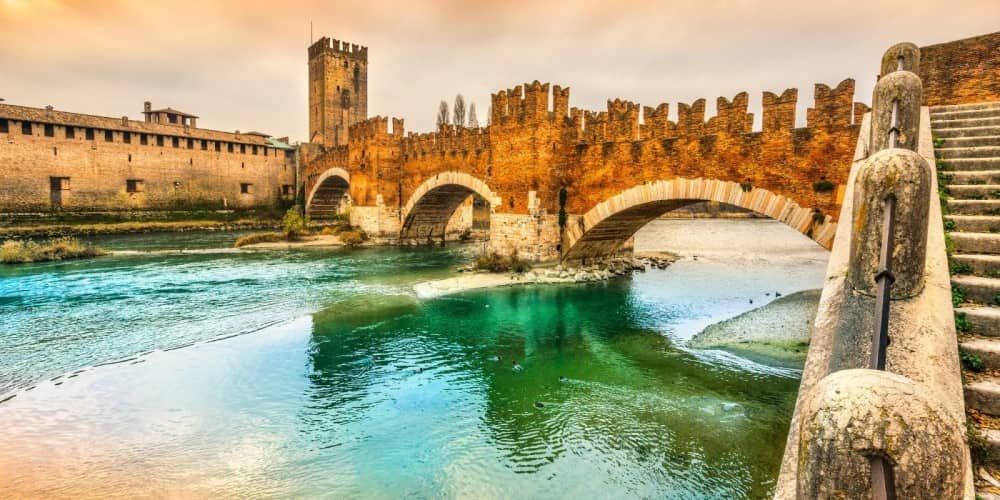
Castelvecchio is a medieval fort located in the historic centre of Verona. It was initially called Castello di San Martino in Aquaro, due to a pre-existing church of the VIII century. The so-called Corte d'Armi (Court of Arms) was later build in its place. The toponym Aquaro can be traced back either to the proximity of the Adigetto (aquarium or canal), or to a bridge (Quaro) that would cross the same canal or river Adige. The fortress took the name Castelvecchio following the construction of Castel San Pietro by the Visconti family.
Between 1943 and 1944 the trial of Fascism took place here, during which the State dismissed Benito Mussolino from his position as Prime Minister.
It is currently the seat of the Civic Museum of the same name. There is no doubt that this is the most important military monument of the Scaliger lordship, as well as one of the most interesting castles in Italy.
Discover all the Verona’s beauty17. Monteursino Castle in Noli (Liguria)
One of Italy's must-see castles is undoubtedly Monteursino Castle in Noli, located in the province of Savona. Likely built in the 10th century at the behest of the Del Carretto family, a noble and powerful feudal dynasty that ruled the area, it served defensive purposes as well as a symbol of the grandeur of the fief, which was twinned with and allied to Genoa, then a Maritime Republic.
Today, the castle features an intriguing exhibition of ancient swords and armor (one of which can even be worn for an unforgettable photo!). Its location, perched about 120 meters above sea level, offers breathtaking views of the stunning Ligurian Riviera.
16. Este Castle in Ferrara (Emilia Romagna)

The Este Castle, also called Castello di San Michele, is the most representative monument of Ferrara. The Este family built it in 1385 as a fortress for political and military territorial control and defence. Above all, it was meant to be a repressive instrument against the riots that could've followed the further increase in taxes.
The castle is in the centre of the renaissance city. A peculiar feature of the building, and symbol of Ferrara, are its four towers from where it's also possible to enjoy a panoramic view of the entire city.
Over time, the fortress, which is now a cultural asset, became a government and administrative seat. Since the 20th century, it's also a temporary and permanent museum.
15. Sammezzano Castle in Leccio (Tuscany)
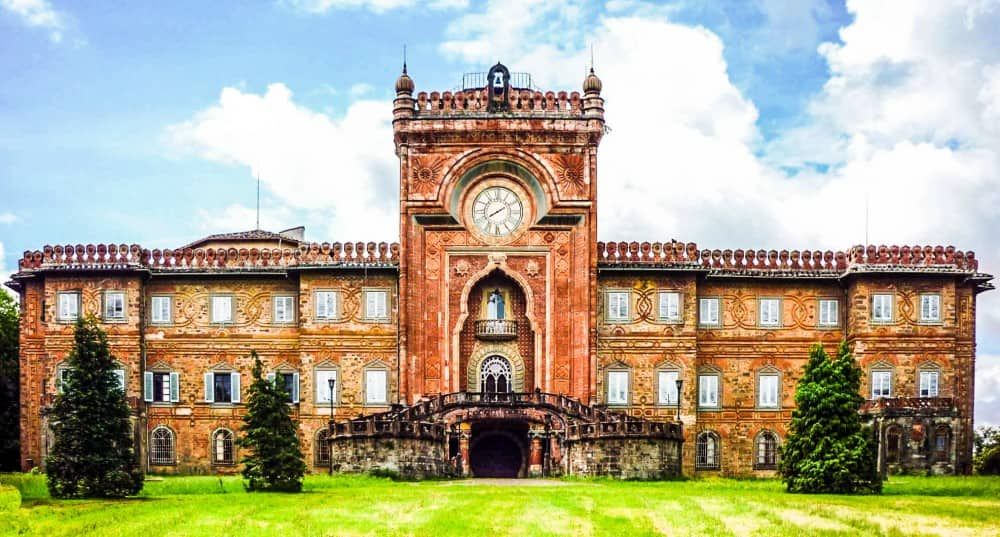
30 km from Florence stands the beautiful Sammezzano Castle,which belonged to one of the most influential families of the Florentine aristocracy: the Panciatichi Ximenes of Aragon. Made in the 19th century by the brilliant mind of Ferdinand, it has a most interesting history told by its colorful rooms, decorated with elaborate polychrome Oriental-style stuccos.
This magnificence hosted a hotel-restaurant for a period, then was closed and opened only during FAI days. Nevertheless, it remains one of the most beautiful and fascinating castles in Italy, reachable in less than an hour not only from Florence, but also from the wonderful Siena.
14. Rock of Arquata del Tronto (Marche)
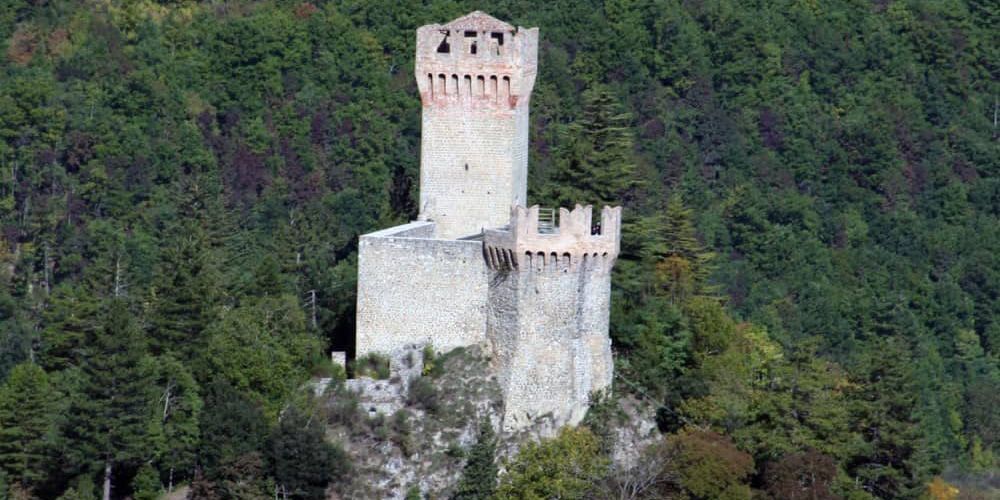
The Fortress of Arquata del Tronto is a medieval fortress erected as a stronghold designed to watch over the territory. It is located on a cliff in Arquata del Tronto, a town in the province of Ascoli Piceno. Secluded and austere, the fortress is surrounded by a green park marked by paths and lanes. Since 1902, the fortress has been classified as a National Monument of Italy.
The history of this fortress is linked to the legend of Queen Joan known as The Mad, probably Joan of Anjou. She used to invite young shepherds to her room, on the highest tower, to be entertained during the night. Their fate depended on her unquestionable judgment, and if dissatisfied, she would hang them from the towers.
13. Alviano Castle in Terni (Umbria)
In the heart of central Italy, in Umbria, stands one of the most notable castles in Italy: Alviano Castle in Terni.
Located on a hill on the left bank of the Tiber River, the castle takes its name from the ancient family that built it, led by the commander Bartolomeo d'Alviano, who ruled it until the 19th century. At its entrance, a statue of a lion and a Medusa head symbolize the fief's authority. Later, the castle became part of the estate of Prince Andrea II Doria Pamphilj Landi, which is why it is also known as the Doria Pamphilj Castle.
Today, the imposing structure houses the municipal offices, the Museum of Rural Civilization, and the Museum of Mercenary Captains, featuring virtual simulations that recount the exploits of Bartolomeo d'Alviano. An additional gem is the private chapel, adorned with 17th-century frescoes depicting the life of Saint Francis.
12. Orsini-Odescalchi Castle in Bracciano (Lazio)
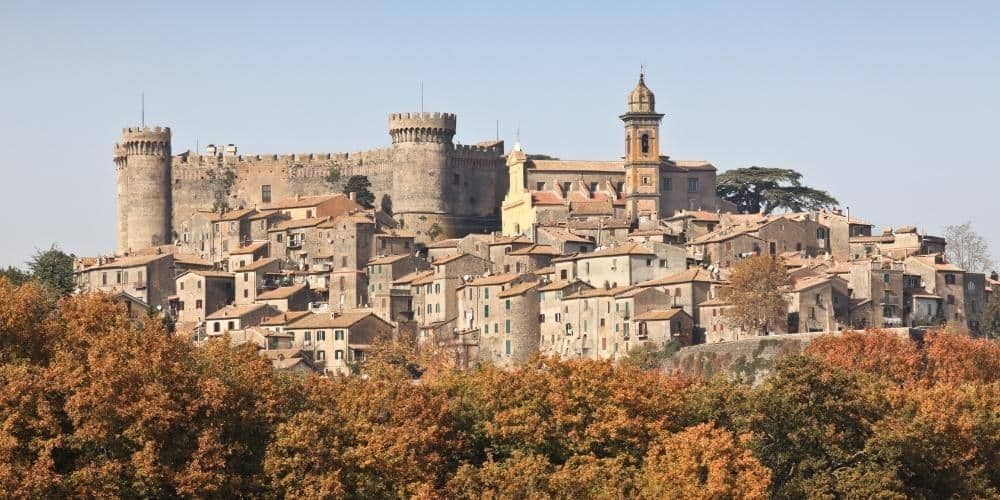
The Orsini-Odescalchi Castle, also known simply as Castello di Bracciano, is a 15th-century castle in Bracciano (Rome).
It consists of three outer walls and five towers, one at each vertex of the outer fortification. It was built after 1470 by Napoleone Orsini, probably collaborating with Sistine workers.
Initially, the castle belonged to Braccio da Montone, of the Bracci House, then for political reasons, upon a Pope's request, it was given to his subordinate Captain Orsini. The evidence of this is the coat of arms of the municipality: an arm holding a rose (one of the symbols of the Orsini). But what was the reason for this favoritism? Because Napoleon's brother, Cardinal Latino Orsini, was the Pope's chamberlain when the castle and the Sistine Chapel were being built.
Today the castle is property of the Odescalchi, a family that took over the Duchy of Bracciano from the Orsinis at the end of the 17th c. Today, since 1952, the castle has been available for guided tours or ceremonies. It can be easily reached by train, for a wonderful trip if you are if you're visiting Rome.
11. Castel Sant'Angelo in Rome (Lazio)
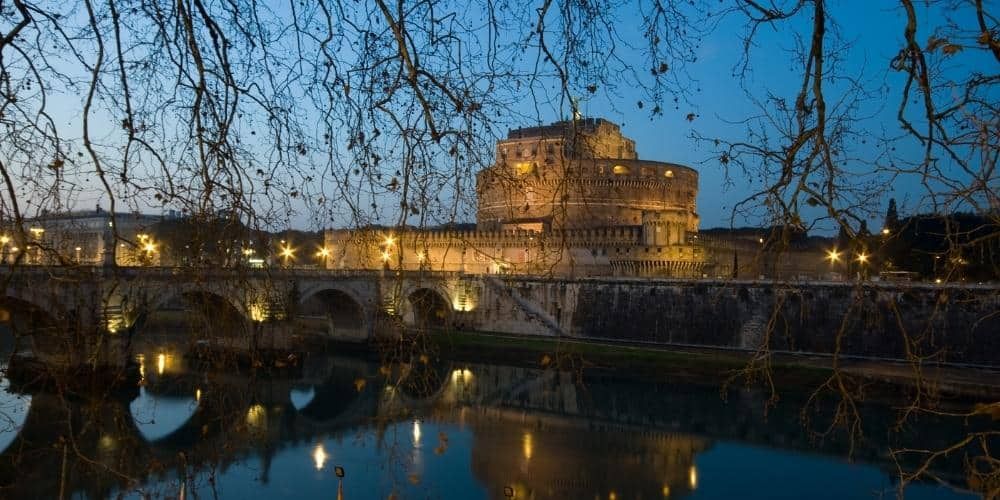
Castel Sant'Angelo in Rome is perhaps the oldest among the castles in Italy. In 123 AD, it used to be the monumental crypt for Emperor Hadrian and his family.
In the historical-artistic panorama of Rome, the castle has an atypical fate: while all other monuments from the Roman era were being swept away, reduced to ruins or quarries of spoil to be recycled into new, modern buildings, Castel Sant'Angelo went along with the events of the city for almost two thousand years. It turned from a funerary monument into a fortified outpost, then from a dark and terrible prison it became an enchanting Renaissance residence to which Michelangelo's art contributed. It later became a prison again at the time of the Risorgimento, until it finally evolved into the modern-day museum. Castel Sant'Angelo embodies in its solemn Roman spaces, solemn walls, and sumptuous frescoed halls the events of the Eternal City, where past and present appear inextricably linked.
Today it is by far among the best known and most visited monuments in Rome, to be included even in the easy-to-use Visit Rome Pass.
Take an access to Castel Sant’Angelo
10. Rocca Calascio (Abruzzo)
Let’s continue our journey among the most beautiful castles in Italy with Rocca Calascio, located in the province of L’Aquila, near Gran Sasso. Standing at over 1,400 meters above sea level, it is the highest castle in Europe.
Rocca Calascio is a symbol of Abruzzo, with uncertain origins. Some sources link its construction to Roger II of Hauteville during the Norman period, while others suggest a Roman predecessor on whose ruins the current structure was built. Over the centuries, various noble families and dynasties owned the castle, but repeated earthquakes led to its abandonment in the 20th century.
Today, it is one of the region’s most visited landmarks, thanks to the fame it gained in the late 1980s as a filming location for the movie Ladyhawke. Its rugged and ruined appearance adds to its allure, and it was named one of the 15 most beautiful castles in the world by National Geographic.
9. Castel Nuovo in Naples (Campania)

Castel Nuovo, better known as Maschio Angiono, is a symbolic castle of Naples. Castel Nuovo, better known as Maschio Angioino, is an iconic castle in the city of Naples. Its location also contributes to making it one of the most important castles in Italy throughout history. The fortress is located in the heart of the city center, close to the sea, Piazza Municipio, Galleria Umberto I and the many other attractions the city has to offer.
The fortress was commissioned by Charles I of Anjou and immediately assumed its defensive role. Its strategic location near the port helped the Neapolitan rulers sleep soundly and avoid enemy incursions. Today it is the seat of the Neapolitan Society of National History and the Naples Committee of the Institute for the History of the Italian Risorgimento.
Visit Naples with the Naples Pass8. Aragonese Castle in Ischia (Campania)
Ischia, the largest island in the Gulf of Naples, is home to the Aragonese Castle. Alfonso of Aragon built it in the 15th century on an islet already occupied by the Greeks centuries earlier.
The castle will take you on a long journey through time: from the splendours of Vittoria Colonna's wedding to the British bombing of 1809. After a period of total abandonment, this awesome site went back to its previous splendor, thanks to restoration works, born from the intuition of a far-sighted lawyer who lives on the island.
The castle of Ischia is among the most important castles in Italy because it embodies twenty-five centuries of history among churches, convents, prisons, lush gardens and breathtaking viewpoints suspended between the sky and the sea in an atmosphere out of time.
Explore Ischia and its treasures7. Swabian Castle of Termoli (Molise)
Heading to Molise, we find one of Italy's lesser-known yet no less fascinating castles: the Swabian Castle of Termoli, located in the province of Campobasso. Overlooking the Adriatic Sea, it stands in the historic center of the town, a significant tourist destination in the region. Built in full Norman style, it was commissioned by Frederick II of Swabia around the 13th century as part of his plans for a series of fortifications across southern Italy.
Having been destroyed multiple times by earthquakes and subsequently restored over the centuries, the castle now houses a museum and hosts various events, including civil weddings for those who dream of a fairytale setting on their special day. However, the highlight is undoubtedly the fire of the Feast of the Assumption (Ferragosto), spectacular cascade of fireworks from the castle's towers reenacts the Turkish assault led by the warrior Piali Pasha in 1566.
6. Melfi Castle (Basilicata)
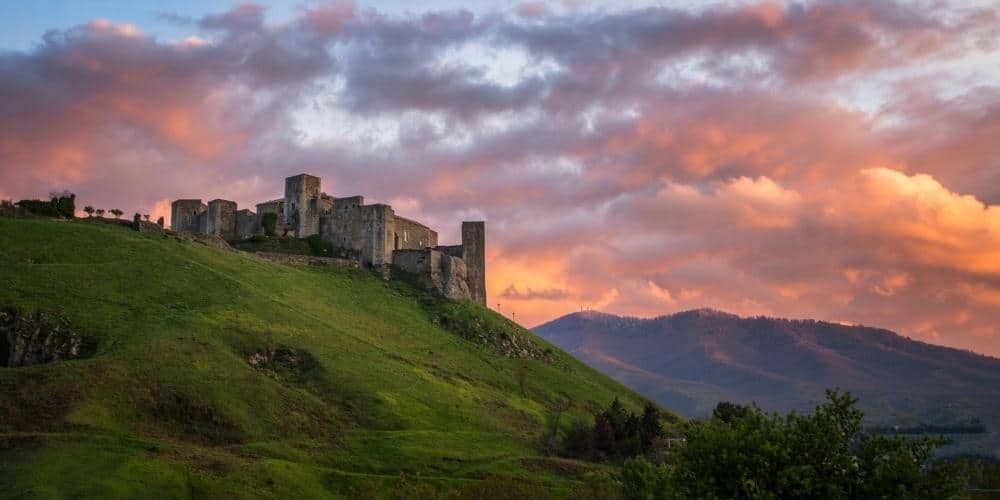
Among the most beautiful castles in Italy, the castle of Melfi cannot be missed. It stands on a volcanic hill and overlooks both the historic centre and the entire town. It had a typical medieval town-castle aspect, with still untouched city walls tightening, in a compact and insurmountable defense, the entire township. Its defense system consisted of a moat, a rampart and a ten-tower wall, seven with a rectangular plan and three with a pentagonal plan.
The castle was built thanks to Guglielmo d’Altavilla in 1042. Here the court held four papal councils, and in 1089 the first crusade to the Holy Land was launched by Pope Urban II. The castle later came into the ownership of Emperor Frederick II of Swabia, and here he proclaimed the Melfitan constitutions in 1231.
Today the castle of Melfi houses a national archaeological museum in which priceless artifacts are collected from various graves from the Volture-Melfiarea.
5. Castel del Monte in Andria (Apulia)
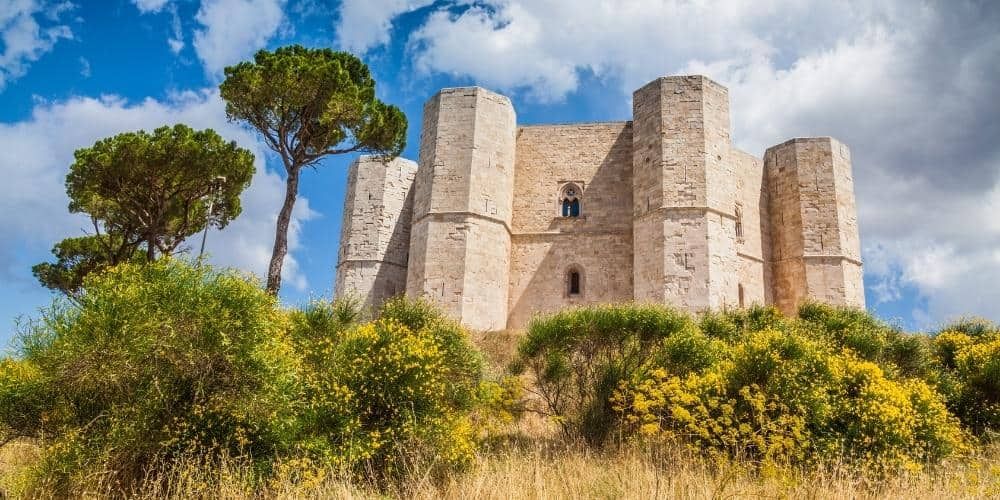
Castel del Monte stands in Andria, close to Bari. It's one of the most misteryous castles in Italy and it's also a UNESCO World Heritage Site. Its plan is a perfect octagon, built according to the mysterious laws of sidereal space.
The castle is located on one of the highest elevations of the Murge, but it takes very little to realise that it is not a military building: there is no moat, no drawbridge, no positions for bows and crossbows, no machicolations, no stables, no dormitories, no kitchens, no storerooms, no dungeons for prisoners.
Frederick II built it in the 13th century for reasons that are obscure even today. There are no relevant documents about it, except for a few letters referring to the court as a hunting lodge. Anyway, considering the height of its walls of just over 20 metres, it is unlikely that Frederick II thought of the castle as a place for his hunting parties.
It is much more likely that these walls had something to do with the sun and the zodiac. The architects may have designed a plan drawn by the sun, thus the castle would be a sundial of some sort.
4. Le Castella in Capo Rizzuto Island (Calabria)
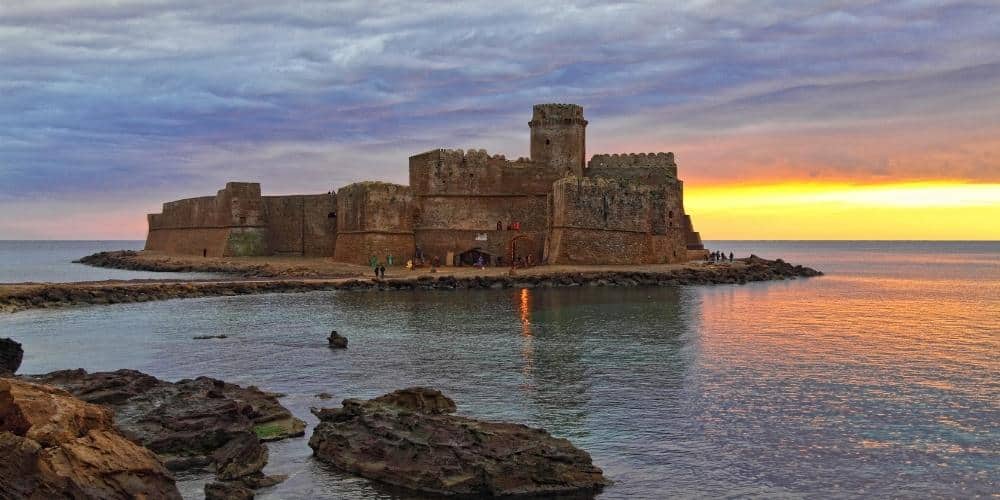
The fortress of Le Castella stands on a small strip of land opposite the island of Capo Rizzuto and towers majestically over the nature reserve of the same name. Its current appearance results from a sum of historical superimpositions over several centuries. The fortress' building probably was in the Hellenistic period as a military outpost. The construction dates back to around the 4th or 3rd century BC due to a wall in the seabed beneath it.
The fortress as we know it today was built by the Aragonese and Angevins and never housed the local nobility. During the visit to the fort of Le Castella, in one of its rooms, you can admire the marine protected area of the Saracen Coast. Thanks to an underwater camera it is possible to see the depths of the Ionian Sea, one of the most beautiful and untouched in Italy.
3. Caccamo Castle (Sicily)
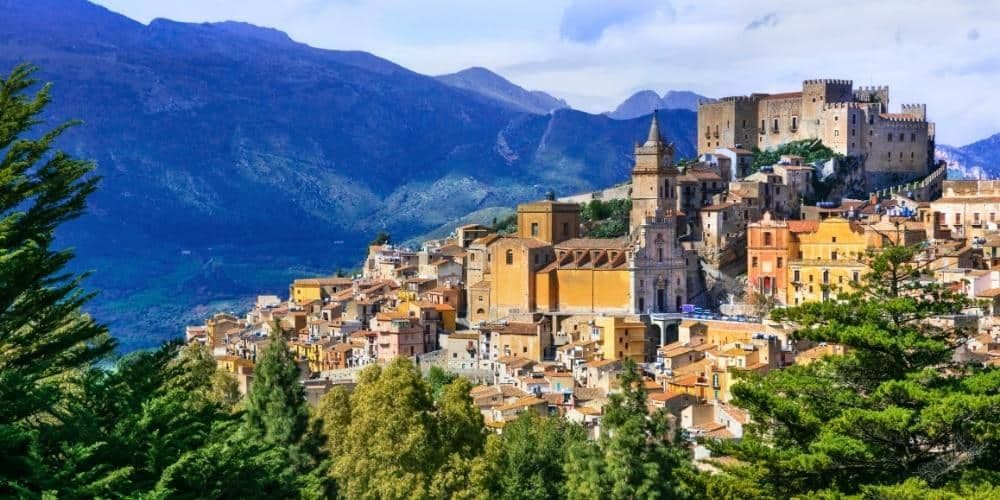
On the road from Palermo to Messina, at the foot of Monte San Calogero, there's the medieval hamlet of Caccamo, overlooked by one of the biggest and most charming castles in Italy. The first historical information dates back to 1160, but history intertwines with legend.
It is said that two ghosts haunt there, one is that of Matteo Bonello, one of the first owners of the castle, who was brutally tortured; the other is the ghost of a young princess who fell in love with a soldier. The king, opposed to their relationship, arranged to kill the man and confine his daughter in a convent, who died shortly afterwards. Since then both ghosts, during full moon nights, have been restlessly roaming the palace.
Besides the ghost stories, however, the castle also holds much beauty. From its terraces it is possible to enjoy a breathtaking view, and the gaze floats among the green hills of the Sicilian hinterland and the iridescent blue of the Cefalù sea.
2. Ursino Castle in Catania (Sicily)
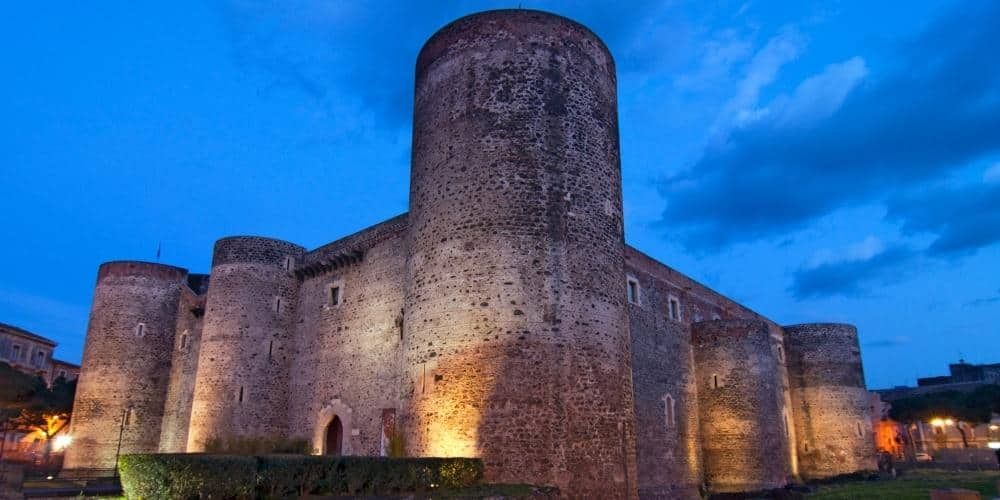
Ursino Castle in Catania was built by Frederick II of Swabia in the 13th c. The manor had some visibility during the Sicilian Vespers, as the seat of parliament, and later was the residence of the Aragonese monarchs of Sicily, including Frederick III. Today it is home to the Civic Museum of the city of Etna, consisting mainly of the Biscari and Benedictine collections.
The castle was used as a prison. The large rooms on the ground floor were divided by new walls and floors, which created smaller rooms in which prisoners stayed like “damned souls” in so-called dammusi, which are small dark cells infested with rats, scorpions and tarantulas. Traces of this page of the history of the castle can be found in the hundreds of graffiti marks that fill the walls in the rooms on the ground floor and also the inner courtyard.
1. Acquafredda Castle in Siliqua (Sardinia)
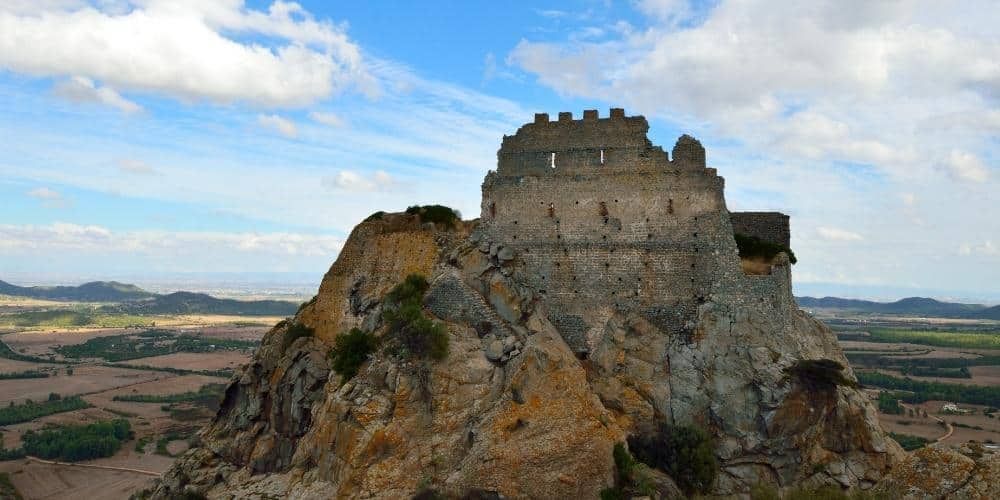
We have come to the end of our journey among the castles of Italy. The Castle of Acquafredda is an essential evidence of a fortified structure of the Middle Ages, located in Siliqua in southern Sardinia, about 30 km from Cagliari. It stands on a 256-metres-high volcanic hill. The site, called Domo Andesitico di Acquafredda, has been declared a Natural Monument by the Region of Sardinia.
According to a pope bull dated 30 July 1238, the castle already existed since then, but it's still said that the famous Pisan nobleman Ugolino Della Gherardesca, Count of Donoratico, built it in 1257. In that year he became Lord of the southwestern part of Sardinia after the fall of the Giudicato of Cagliari. The count then fell into disgrace and was imprisoned in Pisa in the Torre dei Gualandi, later called the Torre Della Fame, where he died in 1288. The story of Count Ugolino became famous thanks to the profound verses of Dante Alighieri in the Divina Commedia (Inferno canto XXXIII).
The castles of Italy: a fairytale journey across the Boot
The castles mentioned above are just a few of the many stunning fortresses you can encounter throughout Italy. Traveling from north to south, and across the islands, you’ll find countless others — perhaps less famous but equally majestic and captivating.
A fairytale Italy, evoking the past glories and now shrouded in the mists of history, can come to life anywhere in the country. All you need to do is choose the region where you’d like to feel like an elegant lady or a fearless knight.
About the author
Written on 28/12/2021

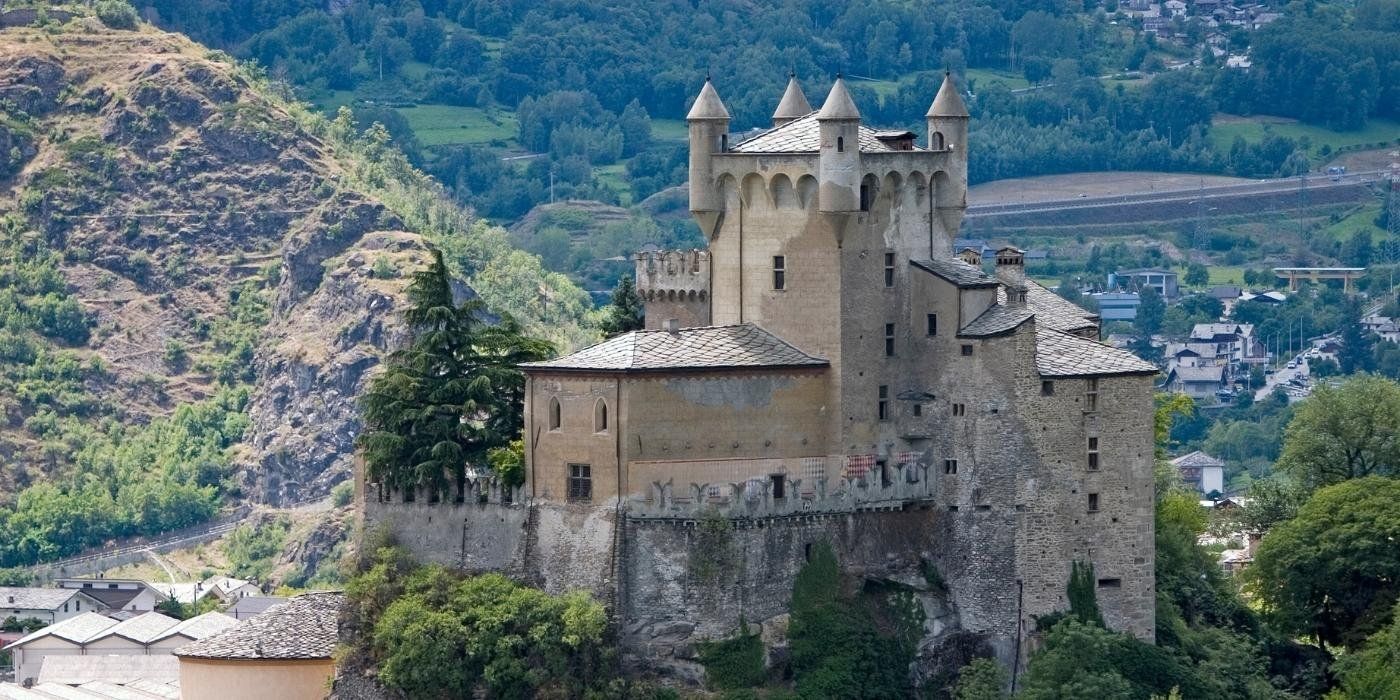

Ludovica Poliero
There are about 45,000 castles, towers and manors in Italy. We have selected what we consider to be the 25 most fascinating castles in Italy